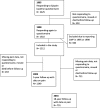Sleep problems and fatigue as predictors for the onset of chronic widespread pain over a 5- and 18-year perspective
- PMID: 30390670
- PMCID: PMC6215341
- DOI: 10.1186/s12891-018-2310-5
Sleep problems and fatigue as predictors for the onset of chronic widespread pain over a 5- and 18-year perspective
Abstract
Background: Previous research suggests that sleep problems may be an important predictor for chronic widespread pain (CWP). With this study we investigated both sleep problems and fatigue as predictors for the onset of CWP over a 5-year and an 18-year perspective in a population free from CWP at baseline.
Methods: To get a more stable classification of CWP, we used a wash-out period, including only individuals who had not reported CWP at baseline (1998) and three years prior baseline (1995). In all, data from 1249 individuals entered the analyses for the 5-year follow-up and 791 entered for the 18-year follow-up. Difficulties initiating sleep, maintaining sleep, early morning awakening, non-restorative sleep and fatigue were investigated as predictors separately and simultaneously in binary logistic regression analyses.
Results: The results showed that problems with initiating sleep, maintaining sleep, early awakening and non-restorative sleep predicted the onset of CWP over a 5-year (OR 1.85 to OR 2.27) and 18-year (OR 1.54 to OR 2.25) perspective irrespective of mental health (assessed by SF-36) at baseline. Also fatigue predicted the onset of CWP over the two-time perspectives (OR 3.70 and OR 2.36 respectively) when adjusting for mental health. Overall the effect of the sleep problems and fatigue on new onset CWP (over a 5-year perspective) was somewhat attenuated when adjusting for pain at baseline but remained significant for problems with early awakening, non-restorative sleep and fatigue. Problems with maintaining sleep predicted CWP 18 years later irrespective of mental health and number of pain regions (OR 1.72). Reporting simultaneous problems with all four aspects of sleep was associated with the onset of CWP over a five-year and 18-yearperspective, irrespective of age, gender, socio economy, mental health and pain at baseline. Sleep problems and fatigue predicted the onset of CWP five years later irrespective of each other.
Conclusion: Sleep problems and fatigue were both important predictors for the onset of CWP over a five-year perspective. Sleep problems was a stronger predictor in a longer time-perspective. The results highlight the importance of the assessment of sleep quality and fatigue in the clinic.
Keywords: CWP; Insomnia; Longitudinal study; Musculoskeletal pain; Population study; Prospective study.
Conflict of interest statement
Ethics approval and consent to participate
All study participants signed an informed consent before entering the study. The study was approved by the Regional Ethical Review Board, Faculty of Medicine, University of Lund, Sweden (Dnr LU 389–94; Dnr 2016/132).
Consent for publication
Not applicable
Competing interest
The authors declare that they have no competing interests.
Publisher’s Note
Springer Nature remains neutral with regard to jurisdictional claims in published maps and institutional affiliations.
Figures



References
-
- Viniol A, Jegan N, Leonhardt C, Brugger M, Strauch K, Barth J, Baum E, Becker A. Differences between patients with chronic widespread pain and local chronic low back pain in primary care--a comparative cross-sectional analysis. BMC Musculoskelet Disord. 2013;14:351. doi: 10.1186/1471-2474-14-351. - DOI - PMC - PubMed
MeSH terms
LinkOut - more resources
Full Text Sources
Medical

